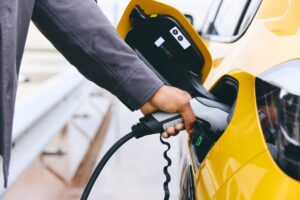
British companies installed a record number of public electric car chargers during 2022 as they raced to dominate a fast-growing and potentially lucrative market.
There were more than 8,700 public chargers installed in the UK during the year to 22 December, bringing the total available to more than 37,000, according to Zap-Map, a data company. That represented a 30% year-on-year increase, slower than the 38% annual growth in sales of battery electric cars during the year to November.
Boris Johnson’s government announced a target of 300,000 publicly available chargers by 2030, when the sale of new pure petrol or diesel cars will be banned. Year-on-year growth of 30% in the number of chargers installed would be enough to hit the target, although that would mean annual installations more than doubling to 19,000 by 2025 and accelerating from there.
Despite the scale of the challenge, many in the industry regard the 300,000 target as realistic, according to Ben Nelmes, chief executive of New Automotive, a thinktank. Charger companies have more investment coming in than they can put to work, but problems may remain where local authorities are slow to act, he said.
Chris Pateman-Jones, chief executive of Connected Kerb, which plans to install 190,000 on-street chargers by 2030, said he expected a further significant increase in charger numbers during 2023, but “much more needs to be done if the country is to be EV-ready for 2030”.
Local authorities need to install “hundreds, even thousands, of charging points in their area – not just a handful”, while central government also has a role to play in locations such as NHS sites, he said.
“Scale remains the greatest challenge facing the EV industry, but installing in the right places where there is the greatest need is also critical,” he said. “Collaboration between central government, local authorities, businesses and charging point operators is a prerequisite to unlocking the funding needed for a full transition, as is winning the hearts and minds of local communities about the benefits of electric vehicles.”
Some electric car owners reported queues for chargers between Christmas and the new year, during one of the busiest periods for long-distance journeys. However, Melanie Shufflebotham, Zap-Map’s co-founder and chief operating officer, said “en route” rapid and ultra-rapid chargers were “going in at a pretty good rate” with nearly 1,000 additions during 2022.
Rapid and ultra-rapid chargers are capable of delivering more than 25 kilowatts (kW) and more than 100kW of power respectively, adding as much as 200 miles of charge within half an hour.
The ultra-rapid market has attracted significant funding from companies including carmaker Tesla, Instavolt and oil companies Shell and BP. En route charging offers the promise of a steady stream of users willing to pay a premium for quicker top-ups – as well as a captive audience for shops and restaurants at the services.
However, Shufflebotham said the number of slower on-street chargers was growing “quite rapidly, but patchily”, in part because of very different approaches from local authorities.
In 2022, there were 7,000 new “slow” or “fast” chargers capable of up to 22kW. On-street chargers, which can charge cheaply overnight, will be crucial for the millions of households who lack private off-street parking.
Read more:
Record number of public electric vehicle chargers installed in UK in 2022





